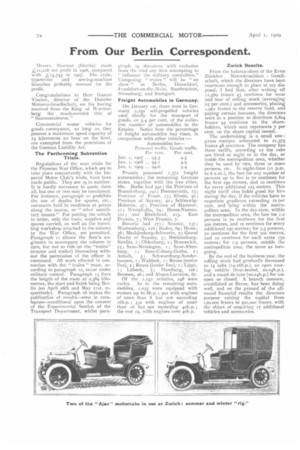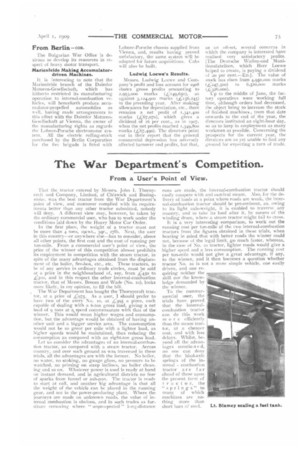From Our Berlin Correspondent.
Page 6

Page 7

If you've noticed an error in this article please click here to report it so we can fix it.
lessrs. Stoewer (Stettin) made L.:11,228 net profit in 19a, compared with L15,743 in 1907. The cycle, typewriter and sewing-machine branches probably account for the profit.
Congratulations to Herr Gustav Vischer, director of the Daimler Motoren-Gesellschaft, on his having received from the King of Wurtemberg the much-coveted title of " Kommerzienrat."
Commercial motor vehicles for goods conveyance, so long as they possess a maximum speed capacity of 25 kilometres an hour on the level, are exempted from the provisions of the German Liability Act, The Forthcoming Subvention Trials.
Regulations of the next trials for the Prussian War Office, which are to take place concurrently with the Imperial Motor Club's trials, have been made public. They are 19 in number. It is hardly necessary to quote them all, but one or two may be mentioned. For instance, paragraph in prohibits the use of depots for spares, etc., assistants held in readiness at points along the course, or " other unmilitary means." For putting the vehicle in order, only the tools, supplies and spares carried, as well as the travelling workshop attached to the column by the War Office, are permitted. Paragraph it allows the firm's engineers to accompany the column in cars, but not to ride on the "trains" (tractor and trailer) themselves without the permission of the officer in command, All work effected in connection with the " trains" must, according to paragraph 12, occur under military control. Paragraph 13 fixes the length of the route at 2,384 kilometres, the start and finish being Berlin (on April 26th and May 21st, respectively). Paragraph 16 makes the publication of results—even in catalogues—conditional upon the consent of the Experimental Section of the Transport Department, whilst para graph 19 thrcaiens with exclusion from the trial any firm attempting to influence the military controllers." Competing " trains " will be " on show " at Berlin, Dusseldorf, Frankfort-on-the-Main, Saarbriicken, Strassburg, and Stuttgart.
Freight Automobiles in Germany. On January 1st, there were in Ger many 2,252 self-propelled vehicles
used chiefly for the transport of goods, or 5.4 per cent, of the collective number of automobiles in the Empire. Notice how the percentage of freight automobiles has risen, in comparison with other vehicles :— Automobiles for— Personal traffic. Goods traffic.
Per rent. Per cent.
Jan. 1, 1907 ... 95.5 4-5 Jan. r, 1908 ... 95.1 4-9 JanI, 1909 ••• 94-6 5-4 Prussia possessed 1,372 freight automobiles ; the remaining German states, together with the free cities, 880. Berlin had 592; the Province of Brandenburg, 192; Pommerania, 13; Province of Posen, 13; Silesia, so ; Province of Saxony, 42; SchleswigHolstein, 47; Province of Hanover, 31; Westphalia, 64; Hesse-Nassau,
to] ; and Rheinland, 213. East Prussia, ; West Prussia, 7.
Bavaria had 271; Saxony, 137; Wurtemburg-, '16; Baden, 69; Hesse, 36; Mecklenburg-Schwerin, 2; Grand Duchy of Saxony, 5 ; MecklenburgStrelitz, 2 ; Oldenburg, ; Brunswick, 25; Saxe-Meiningen, ; Saxe-Altenburg, ; Saxe-Coburg-Gotha, 2; Anhalt, 5; Schwarzhurg--Sonderhausen, i ; Waldeck, i ; Reuss (senior line), 2; Reuss (junior line), i ; Lippe, 1; Lubeck, 3 ; Hamburg, to6 ; Bremen, 26; and Alsace-Lorraine, 67. Of the 2,252 vehicles, 248 were cycles. As to the remaining automobiles, 1,035 were equipped with motors up to 8h.p. ; 502 with engines of more than 8 but not exceeding 16h.p. ; 112 with engines of more than r6 but not exceeding 4oh.p.; the rest 19, with engines over 4oh.p. Zurich Results.
From the balance-sheet of the Erste Ziiricher Motordroschken Gesellschaft, which the directors have been courteous enough to place at my disposal, I find that, after writing off 11,569 francs 43 centimes for wear and tear of rolling stock (averaging 25 per cent.) and accessories, placing 1,961 francs to the reserve fund, and paying certain bonuses, the directors were in a position to distribute 6,804 francs 95 centimes to the shareholders, which sum represents 7 per cent. on the share capital issued.
The undertaking is a small one : gross receipts amounted to 21,375 francs 48 centimes. The company has three tariffs, according as the cabs are hired at night or in the day, or inside the metropolitan area, whether they be used by two, three or more persons, etc. At night-time (it p.m_ to 6 a.m.), the fare for any number of persons up to five is 70 centimes for the first 250 metres, and to centimes for every additional 125 metres. This night tariff also holds good for hire during the day, if the vehicles have to negotiate gradients exceeding to per cent. and lying within the metropolitan area. In the day-time, within the metropolitan area, the fare for 1-a persons is 70 centimes for the first 500 metres, and to centimes for every additional 250 metres; for 3-5 persons, 70 centimes for the first 300 metres, and to centimes for each extra ivmetres; for 1-5 persons, outside the metropolitan area, the same as foregoing.
By the end of the business year, the
rolling stock had gradually increased to 14 cabs (14-16h.p.), an open touring vehicle (four-seated, 2o-24h.p.), and a coupe de luxe (20-24h.p.) for use open or closed. A branch concern, established at Berne, has been doing well, and on the ground of the allround financial results the directors purpose raising the capital from 250,000 francs to 5oo,000 francs, with the object of acquiring 17 additional' vehicles and accessories.
The Bulgarian War Office is desirous to develop its resources in respect of heavy motor transport.
Marienfelde Making Accumulator. driven Machines.
It is interesting to note that the Marienfelde branch of the Daimler Motoren-Gesellschaft, which has hitherto restricted its manufacturing operation to internal-combustion vehicles, will henceforth produce accumulator-propelled automobiles as well, having made arrangements to this effect with the Daimler MotorenGesellschaft at Vienna, the owner of the manufacturing rights as regards the Lohner-Porsche electromotor system. All the electric rolling-stock purchased by the Berlin Corporation for the lire brigade is fitted with Lohner-Porsche chassis supplied from Vienna, and, results having proved satisfactory, the same system will be adopted for future acquisitions. Cabs will also be built.
Ludwig Loewe's Results,
Messrs. Ludwig Loewe and Company's profit and Foss account for 1908 shows gross profits amounting to 2,993,000 marks (4:149,6,50), as against 3,124,900 marks '(.4,156,245) in the preceding year, After making allowances for depreciation, etc., there remains a net profit of 1,341,400 marks (L:67,o7o), which gives a dividend of 16 per cent., as in 1907, when the net profits reached T , 349,800 marks (J67,49o). The directors point out in their report that the general commercial depression has adversely affected turnover and profits, but that, as an off-set, several concerns in which the company is interested have realised very satisfactory profits. "The Deutsche Waffen-und Munitionsfabriken, which Herr Loewe helped to create, is paying a dividend of 20 per cent.—ED.J. The value of stock has risen from 4,950,000 marks ;247,500) to 6,52o,000 marks (-1-.326,006). Up to the middle of June, the factory operatives were working full time, although orders had decreased, the object being to increase the stock of finished. machines ; trom that date onwards to the end of the year, the directors instituted an eight-hour day, so as to keep in employment as many workmen as possible. Concerning the prospects for the current year, the directors are as yet unable to find any ground for expecting a turn of trade.






















